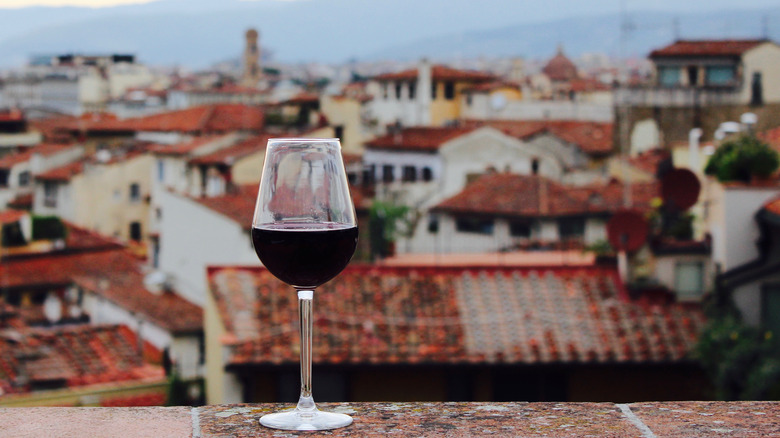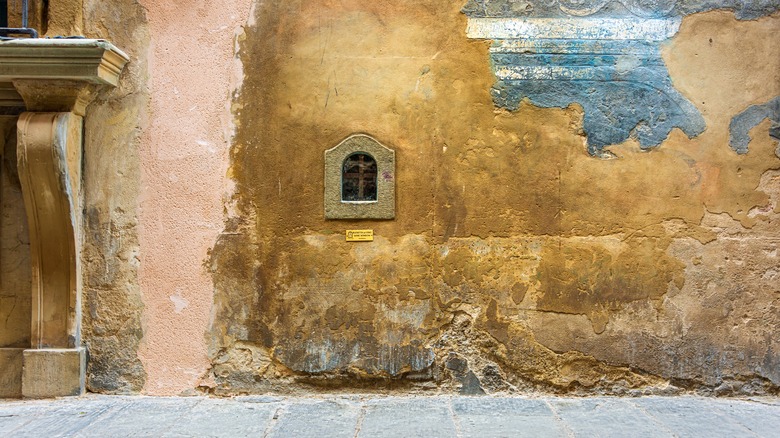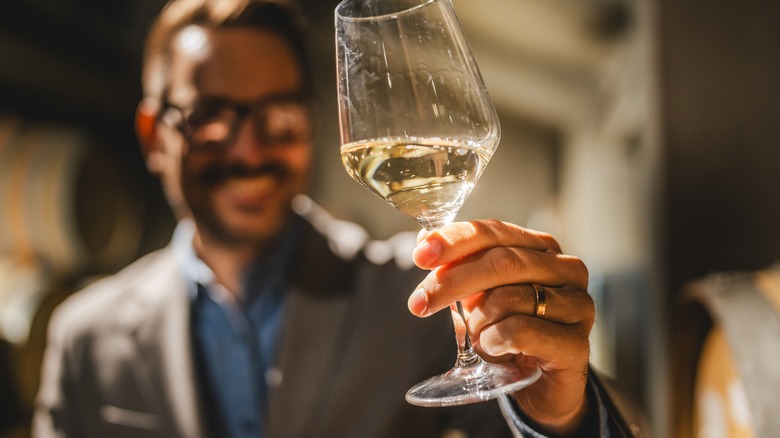What Tourists Need To Know Before Ordering From Italy's Iconic Wine Windows
Known for its sprawling vineyards, historical sites, and stunning coastlines, Italy is what travel dreams are made of. From the country's beautiful beach destinations in the "heel" to the rolling hills in Tuscany and the canals of Venice, there's no shortage of things to do and see. However, few things are as celebrated and talked about as the country's food scene — and with good reason. Whether it's handmade pastas, fresh seafood, or the ever-so-tempting scoops of gelato waiting around pretty much every corner, Italian cuisine is a feast for the senses. But in between the pizzerias and trattorias, there's one iconic detail that isn't as well-discussed: Italy's historic "wine windows."
Officially called "buchette del vino" in Italian, these small, arched openings are typically found in the walls of historic buildings dating back to the 16th century. Originally created to allow local wineries to sell their bottles directly and without paying taxes, the windows took on a whole new purpose during the plague of the 1630s. Since physical contact became so risky, these small openings were a great way to continue selling wine — all without ever having to encounter a person face-to-face.
Today, however, the windows have experienced a sort of resurgence — partly due to the COVID-19 pandemic, when social distancing became the norm. As a means to adapt, many local restaurants and bars reopened these historic portals — offering a unique experience for tourists to order everything from wine to cocktails, food, and even dessert.
Everything you need to know about wine windows
Roughly 12 inches tall by 8 inches wide, Italy's wine windows look similar to a church's and are usually framed in stone or wood, with small hatch-style doors that open outward. In order to use one, all you have to do is walk up to it and give it a quick knock. Some of them even have small bells you can ring. Then, when the hatch opens, simply place your order directly with the server — and, before you know it, you'll have a fresh glass in hand.
In terms of what they sell, today's windows offer a variety of drinks beyond wine. Depending on where you're visiting, some might even serve cocktails, coffee, or food. As for pricing, most wines will typically range from $5.50 to $9 for a glass, while drinks like an Aperol Spritz can set you back roughly $8 to $11. Cash and cards are both welcome in most places, so there's no need to worry about payment. Lastly, depending on the establishment, you might even have the option to stand nearby and enjoy your drink, or — if it's connected to a restaurant — you might have the opportunity to go inside for a full dining experience. (Here's how to find the best authentic restaurants in Italy.)
Where to find a famous Italian wine window during your trip
If you're eager to experience these charming features yourself, look no further than Florence, a destination wine lovers should add to their bucket list. The Tuscan capital has more 180 wine windows scattered across the city — which means you pretty much have 180 opportunities to enjoy the experience.
One of the most popular spots is Babae, which is nestled on the quieter west side of the Arno river in the Santo Spirito neighborhood. The first to officially reopen its wine window in 2019, Babae serves wine by the glass, as well as prosecco and Aperol spritz. Keep in mind, however, that the restaurant (and its window) closes on Mondays — so make sure you don't plan your visit for that day.
Other spots that offer an equally traditional experience include Osteria Belle Donne, which specializes in Tuscan wines and is considered one of the most famous wine windows in the city; Vivoli, which uses their window to serve up some deliciously traditional gelato; DiVin Boccone, one of the most recent windows to start operating in Santo Spirito; and S-Malto Firenze, where you can pair your window-bought wine (or beer) with a comforting pizza. Similarly to Babae, it's best to check ahead of time if the windows are operating so you don't run into a disappointing surprise. Alternatively, the Wine Windows Cultural Association of Florence also offers tours in both English and Italian that'll take you to some of the most iconic spots. Although these don't run very often, they're a great way to get the full historical and cultural context if you're lucky enough to catch one.


